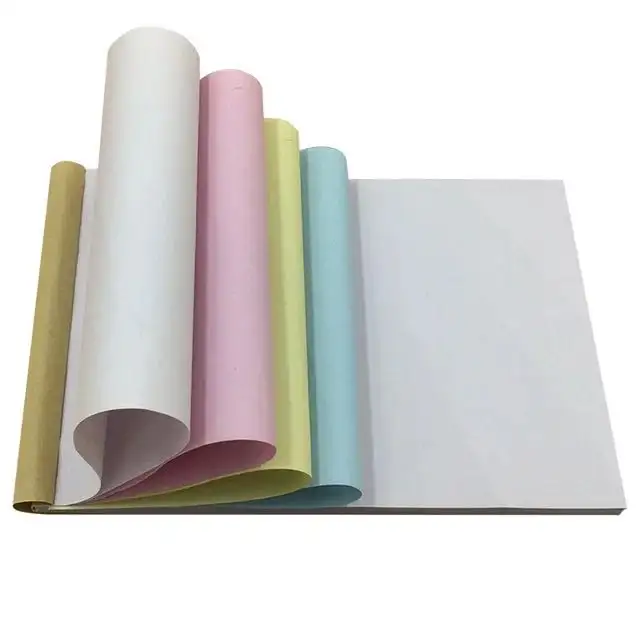

Views: 961 Author: Amanda Li Publish Time: 2023-07-27 Origin: Site









Carbonless copy paper grams 47gsm -200gsm ,
Hot selling grams 48gsm,50gsm,55gsm,60gsm,70gsm .there are five colors white,red,yellow,green and blue; divided blue image and black image
*Classification
Carbonless copy paper can be divided into ROOLS and Sheets. The width of the roll paper can be from 160mm to 1940mm, and the size of the sheet paper can be from 420mm*530mm to 1420mm*1420mm.
hot selling sheet size:
61*86cm(24*34inch),70*100cm,65*92cm,60*100cm,69*89cm,72*92cm,64*91.5cm,787*1092mm,889*1194mm etc
Hot selling rolls width :241mm/381mm/432mm/483mm/525mm etc
*Feature introduction
1) No need to pad "carbon paper" when copying, direct writing is convenient and time-saving, the number of copies is 2-6 pages, and the number of electric printing is 2-10 pages, which can greatly improve work efficiency and meet the needs of modernization.
2) The copy shall be clear, distinct and fadeless, and shall be able to prevent alteration and imitation.
3) Do not contaminate fingers, clothes and other stationery papers, and keep them clean.
4) It has various colors and is easy to identify and process.
5) Excellent paper, smooth and smooth surface, stronger than 28 grams of color paper, not easy to damage, bright printing color.
6) Does not contain harmful raw materials and peculiar smell, is safe and reliable, and can be stored for more than 15 years after color development.
Operation


Until the 1970s, when the use of polychlorinated biphenyls (PCBs) was banned due to health and environmental concerns, PCBs were used as a transfer agent in carbonless copy paper.[3][4][5] PCBs are readily transferred to human skin during handling of such papers, and it is difficult to achieve decontamination by ordinary washing with soap and water.[4] In Japan, carbonless copy paper is still treated as a PCB-contaminated waste.[6]
Exposure to certain types of carbonless copy paper or its components has resulted, under some conditions, in mild to moderate symptoms of skin irritation and irritation of the mucosal membranes of the eyes and upper respiratory tract. A 2000 review found no irritation or sensitization on contact with carbonless copy paper produced after 1987.[7] In most cases, good industrial hygiene and work practices should be adequate to reduce or eliminate symptoms. These include adequate ventilation, humidity, and temperature controls; proper housekeeping; minimal hand-to-mouth and hand-to-eye contact; and periodic cleansing of hands.[8]
In a 1997 study, the University of Florida found that a poorly-ventilated office where large amounts of carbonless copy paper were used had significant levels of volatile organic compounds present in its air, whereas a well-ventilated office where little such paper was used did not. The study also found that there were higher rates of sick leave and illness complaints at the office using large amounts of carbonless copy paper.[9] Another study, which was published in Environmental Health Perspectives, connected chronic occupational exposure to paper dust and carbonless copy paper with an increased risk of adult-onset asthma.[10]
The average carbonless copy paper contains a high concentration of bisphenol A (BPA), an endocrine disruptor.[11][12][13][14][15]
In 2001, three employees of a medical center in San Francisco filed a lawsuit against their employer, blaming exposure to carbonless copy paper and other chemicals for their inflammatory breast cancer.[16]
With the increasing adoption of inexpensive inkjet printers and laser printers on computer systems since the 1980s, the use of carbonless multipart forms in businesses has declined, as it is simpler to make copies of documents.[citation needed]
Workshop corner
*coating workshop
*roll slitting workshop
*sheet slitting workshop
*sheet warehouse
*roll warehouse
Thank you for your attention.
If you have any interests about it, pls contact us freely.
Attn:Amanda Li
Whatsapp/WeChat:+0086 13783698803
Email:sales10@dtpapergroup.com
Website:www.dtpapergroup.com